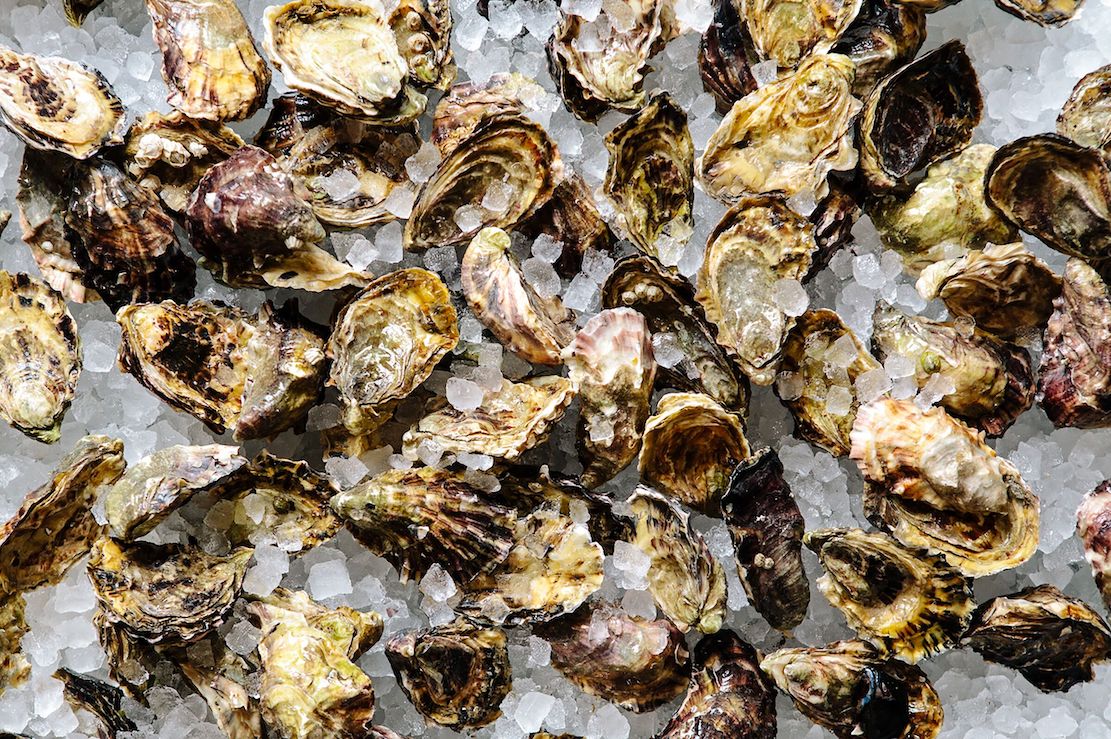MARIANI’S
Virtual
Gourmet
August 14, 2022
NEWSLETTER
IN THIS ISSUE
THE
ENDURING IDIOCY OF
GROVELING FOR AN
“A” TABLE
NEW YORK CORNER
HARRY'S TABLE BY CIPRIANI
By John Mariani
ANOTHER VERMEER
CHAPTER 33
By John Mariani
NOTES FROM THE WINE CELLAR
CHABLIS: A GOOD BISTRO WINE
BUT AN EXCELLENT BURGUNDY, TOO
By John Mariani
❖❖❖


❖❖❖
THE
ENDURING IDIOCY OF
GROVELING FOR AN “A” TABLE

LE CIRQUE, NYC, 1998
At a time when some of the toughest
reservations to get are at storefront eateries
in Brooklyn with long communal
tables, the outdated idea that restaurateurs
deliberately design their dining
rooms to have “good” and “bad” tables is as
preposterous as deliberately
writing a novel with good and bad chapters. As
every restaurateur will tell
you, theirs is a business that depends on the
total utilization of every square
foot of a room to maximize occupancy, while
allowing for flow, décor and the
ability of the kitchen to deliver a certain
amount of food per hour.
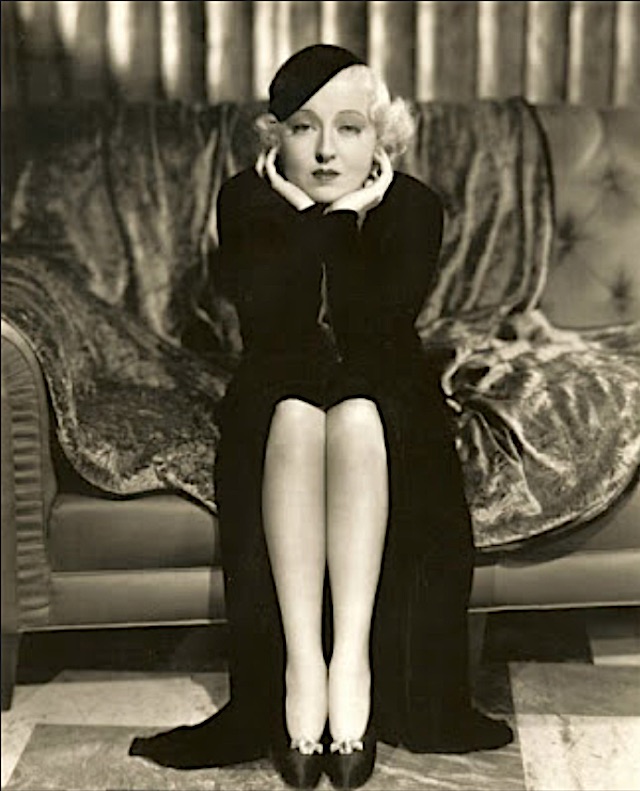 Yes, there
once really was such a thing
as “Siberia,” a term for a section
of a
restaurant dining room considered either socially
inferior or merely poor
seating that was coined back in the 1930s when
society woman Peggy Hopkins
Joyce (left) entered the class-conscious El
Morocco nightclub in New York and found
herself being led to a less than desirable table.
“Where are you taking me,”
she asked the maître d’hôtel, “Siberia?” An
alternate term for Siberia is the
“doghouse,” used by those who frequented
Yes, there
once really was such a thing
as “Siberia,” a term for a section
of a
restaurant dining room considered either socially
inferior or merely poor
seating that was coined back in the 1930s when
society woman Peggy Hopkins
Joyce (left) entered the class-conscious El
Morocco nightclub in New York and found
herself being led to a less than desirable table.
“Where are you taking me,”
she asked the maître d’hôtel, “Siberia?” An
alternate term for Siberia is the
“doghouse,” used by those who frequented 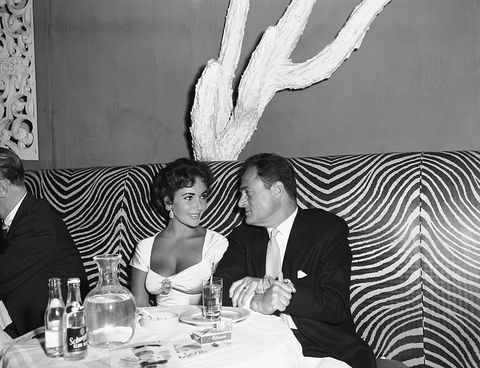 New York City’s Colony
Restaurant,
opened in 1926. An “A” table was one supposedly
given to VIPs that was usually
at a banquette against the wall in full view of
everyone on their way to a
lesser table.
New York City’s Colony
Restaurant,
opened in 1926. An “A” table was one supposedly
given to VIPs that was usually
at a banquette against the wall in full view of
everyone on their way to a
lesser table.
It hardly mattered to such people that the
food and drinks were going to be the same,
although some fools would argue that
a restaurant would have different cooks for
different guests and the chef would
tell his cook that he should make great food for
Table 4 but not to bother with
Table 18, which is a screwy and impossible way to
run a kitchen. A chef doesn’t
keep two pots of goulash on his stove in case Brad
Pitt or a restaurant critic
shows up.
To be sure, in the days of New York's El
Morocco (right), The
Colony and `21” Club, all now defunct, arrant
snobbism did rule—the doorman at
`21’ was once quoted as saying, “Why should I be
nice to everyone? I don’t know
them.” And
I’m well aware that many, if
not most, restaurants have tables that might be
perceived as particularly
pleasant and that faithful, six-times-a-month
customers and, yes, celebrities,
are given those nicer tables, which seems to me to
be good business in the case
of the faithful regulars and obviously worthwhile
in the case of celebs. If you’ve
frequented a restaurant for years, you, too, will
be one of those favored.
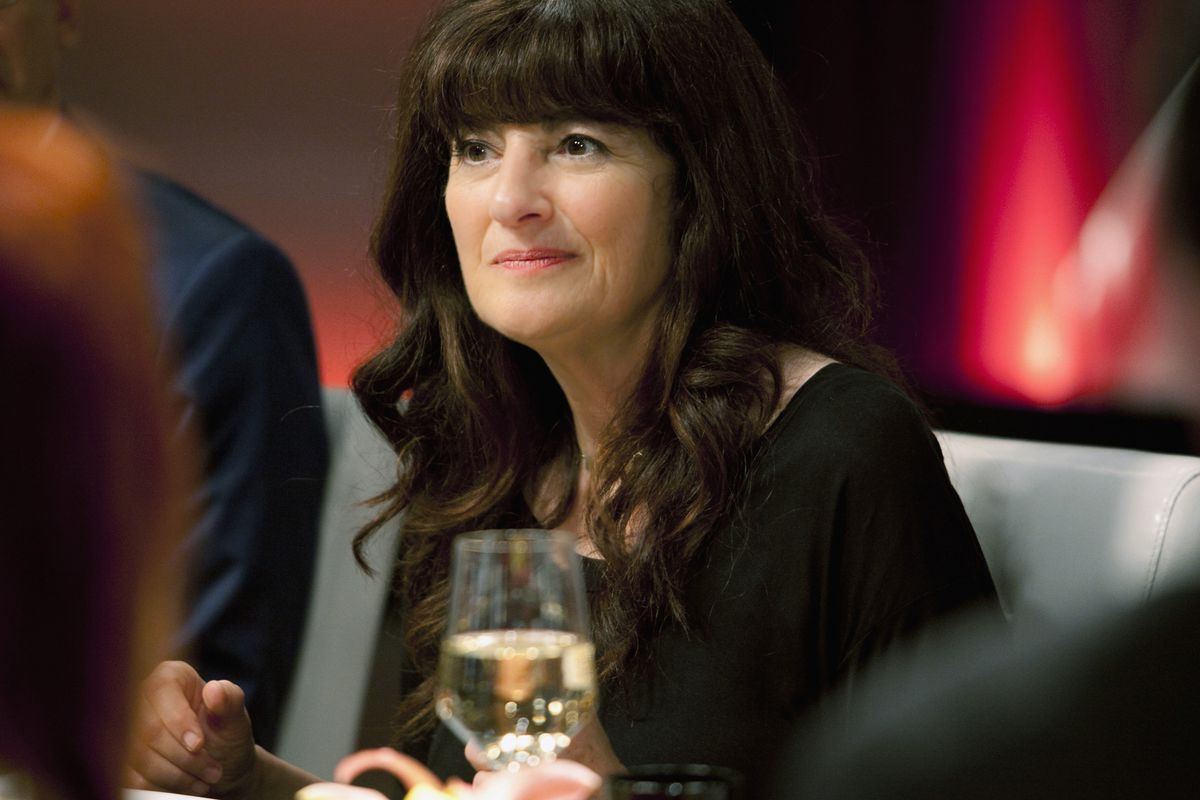 But in so many
cases it is a person’s perception
about the value of a table
that creates trouble. The most notorious example
was when the newly arrived
(from L.A.) New
York Times restaurant
critic Ruth Reichl (left) in the 1990s
wrote a double review of what was then the
city’s most celebrated restaurant, as much for its
food as for its
international clientele and suave owner, Sirio
Maccioni (below), whom Reichl considered
“the most fabulous looking guy you ever saw in
your life.” After eating at the
restaurant six times (the Times
gave
their critics complete carte blanche with
expenses), Reichl contended that when
she was unknown she was given a bad table, endured
rude
But in so many
cases it is a person’s perception
about the value of a table
that creates trouble. The most notorious example
was when the newly arrived
(from L.A.) New
York Times restaurant
critic Ruth Reichl (left) in the 1990s
wrote a double review of what was then the
city’s most celebrated restaurant, as much for its
food as for its
international clientele and suave owner, Sirio
Maccioni (below), whom Reichl considered
“the most fabulous looking guy you ever saw in
your life.” After eating at the
restaurant six times (the Times
gave
their critics complete carte blanche with
expenses), Reichl contended that when
she was unknown she was given a bad table, endured
rude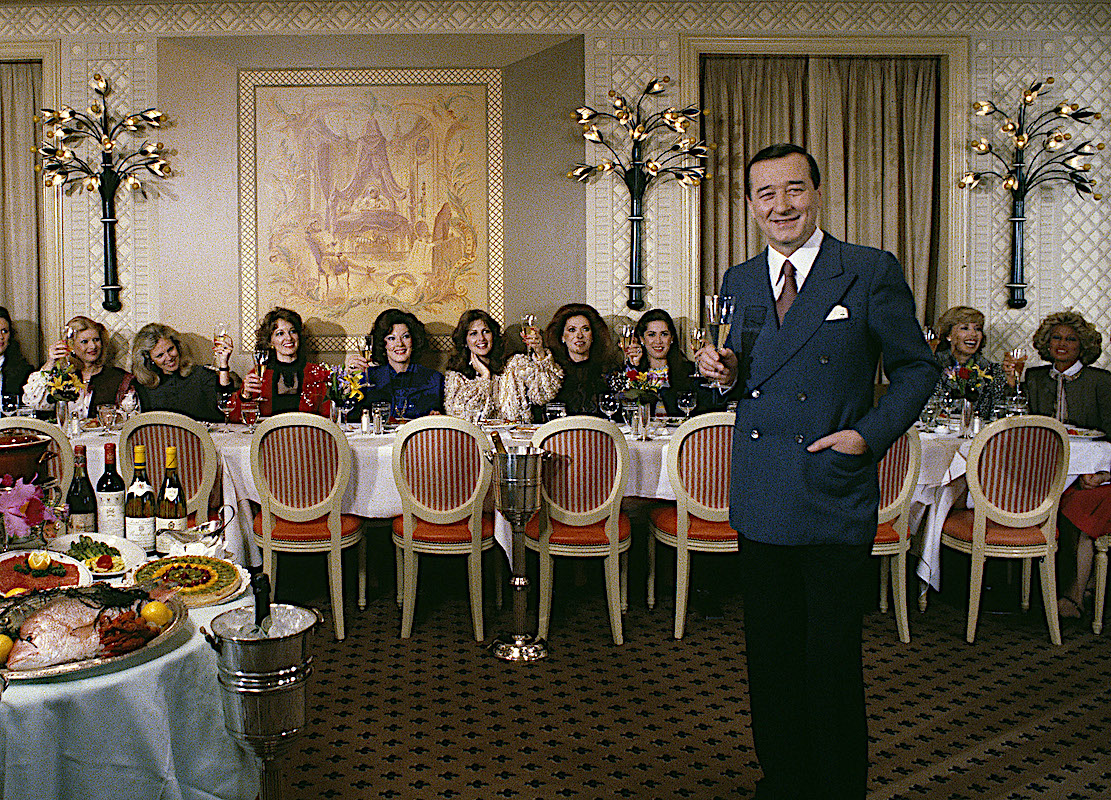 service and ate “a
parade of brown food.” But, she contended, when
“discovered” by Maccioni, she
caved into his considerable charm and had a great
meal. (Four years later she
awarded Le Cirque the top rating of four stars.)
service and ate “a
parade of brown food.” But, she contended, when
“discovered” by Maccioni, she
caved into his considerable charm and had a great
meal. (Four years later she
awarded Le Cirque the top rating of four stars.)
It should be noted that Reichl was easily
recognized all over town because she is a very
distinctive looking woman with
glasses and a mass of curly black hair that she
sometimes covered with a wig,
something no male or female restaurant critic for
the Times had ever done before.
Reichl was not the first to have
complained of a two-tier system of preference at
Le Cirque, but, despite her
insistence that she was undiscovered until that
last meal, Maccioni said she’d
been known from her first visit but they did not
fawn over her, lest they give
the game away. It also never occurred to her that
eating at Le Cirque six times
in a short period might have made her a treasured
regular.  As for the “brown
food” at the start, well, those are dishes she
ordered; when the food got
better, were they the same dishes but no longer
brown?
As for the “brown
food” at the start, well, those are dishes she
ordered; when the food got
better, were they the same dishes but no longer
brown?
Moreover, years later Reichl complained
she was given a terrible table just inside the
entrance of a re-located Le
Cirque, but in fact that was the same table
where
Sophia Loren (left) had been seated the
night before and one favored by many
other celebrities. Such carping has died down in
this present century (and Le
Cirque is closed), and as Maccioni used to say,
“The table does not make the
person; the person makes the table.”
The issue of perception continues,
however, with people who as first-timers find
themselves seated at a perfectly
nice table that they believe is punishment for
their lowly status. Given the
obvious fact that in a dining room of, say, 30
tables, 25 of them are going to
be placed all over the room, with perhaps five up
front or against a window or
banquette. As noted, restaurants are real estate,
but, unlike theaters, arenas
and airlines, restaurants cannot charge extra for
front row seats or
first-class, fully reclining seats.
Which
leads to the heinous practice of
people bribing the maître d’ at a restaurant.
While requisite in season at
Joe’s Stone Crab on .jpeg) Miami
Beach, whose oily maître d’ (right) was
once said to wield more
power than the city’s mayor, payment for a table
marks the average person as a
patsy who will thereafter always be a mark for the
staff. It goes without
saying that former plumbing contractor John Gotti
(below)got preferential treatment at
restaurants because he always tipped the staff the
entire amount of the bill.
Later, of course, he was taking his meals through
a slot in solitary
confinement at Chez Marion Penitentiary.
Miami
Beach, whose oily maître d’ (right) was
once said to wield more
power than the city’s mayor, payment for a table
marks the average person as a
patsy who will thereafter always be a mark for the
staff. It goes without
saying that former plumbing contractor John Gotti
(below)got preferential treatment at
restaurants because he always tipped the staff the
entire amount of the bill.
Later, of course, he was taking his meals through
a slot in solitary
confinement at Chez Marion Penitentiary.
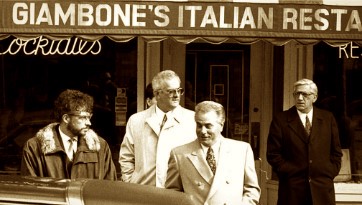 If,
in fact, one does intend to become a regular at a
chosen restaurant, there’s
nothing wrong with making that clear to a maître
d’ and tipping him upon
leaving. He will remember. But to say that only
such payments guarantee good
service and a preferred table is not to understand
how restaurant seating is
arranged on an every night basis.
If,
in fact, one does intend to become a regular at a
chosen restaurant, there’s
nothing wrong with making that clear to a maître
d’ and tipping him upon
leaving. He will remember. But to say that only
such payments guarantee good
service and a preferred table is not to understand
how restaurant seating is
arranged on an every night basis.
Considerations of traffic flow are as
important as knowing how many tables can be
accommodated when the six o’clock
rush begins. Dining rooms have sections assigned
to captains and waiters each
night, and that will change each night. Staff
would grumble otherwise. Thus,
guests must be placed in each and all of those
sections.
Be aware, too, that tips to captains,
waiters, busboys and bartenders are always shared
at the end of the night and,
by law, whatever percentages they decide on cannot
be interfered with. Thus, a
good waiter will get the same amount as a bad
waiter, although the good waiters
will make sure the bad ones don’t stay long in
their jobs. So, to suggest that
a parade of nightly regulars and celebs will only
get the best waiters at the tables
perceived to be the best is simply not in accord with
the way things run in a
restaurant.
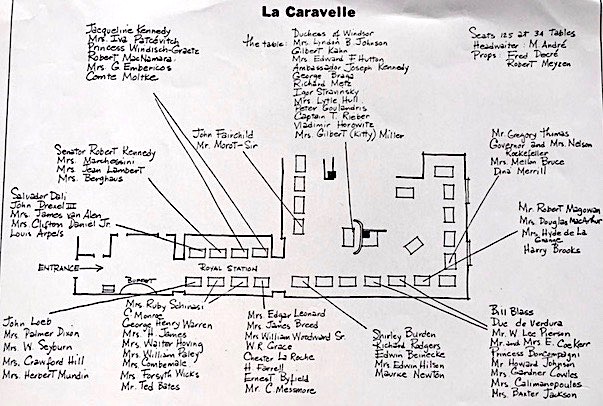 But, what if you are interested in
getting
a “good” table and good service (assuming the
restaurant doesn’t have special
cooks who only cook good food for special people)?
The answer is very simple:
Just ask. Very often upon arrival I have asked to
change tables because the one
over there is empty or the one over there is in a
quieter section. Almost
always (I’m speaking of places I’m not known), my
request is cordially granted.
I am not going to ask for a table I can clearly
see has a “RESERVED” sign on
it.
But, what if you are interested in
getting
a “good” table and good service (assuming the
restaurant doesn’t have special
cooks who only cook good food for special people)?
The answer is very simple:
Just ask. Very often upon arrival I have asked to
change tables because the one
over there is empty or the one over there is in a
quieter section. Almost
always (I’m speaking of places I’m not known), my
request is cordially granted.
I am not going to ask for a table I can clearly
see has a “RESERVED” sign on
it.
It’s certainly not a bad idea, when
possible, to drop by the restaurant earlier and
see what the lay-out and the
prospects will be for dining there that night—and
remember, everything is
easier at lunch. Or call ahead and tell the maître
d—not the person who answers the
phone!—about your preferences: This
will be a business meal where you need some quiet
reserve; or a romantic
dinner, perhaps a celebratory anniversary or
birthday; or a meal with an
elderly person who may need some help getting in
and out.
Remember,
restaurants are service
businesses; they are not in the business of
shunning, ridiculing or losing
customers unless they are rude and boisterous.
Restaurateurs work very hard to
win your business and they can only do that by
winning you over. Let them do so
in their own cordial way. Or you could always try
to get a reservation at that
communal table at the storefront in Brooklyn. Good
luck with that.
❖❖❖
HARRY’S TABLE BY CIPRIANI
235
Freedom Plaza South, at Waterline Square
212-339-2015
By John Mariani
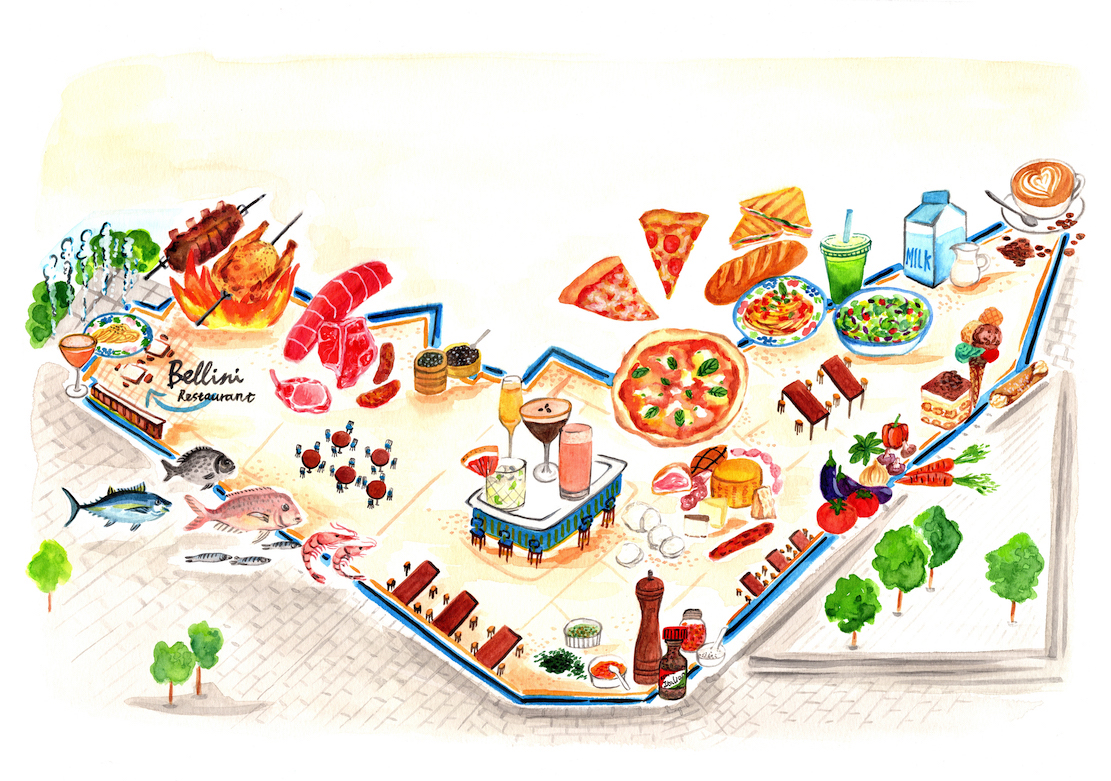
New
Yorkers
have never wanted for Italian specialties shops,
but New Yorkers have
never seen anything quite like the new Harry’s
Table by Cipriani (hereafter
HTC), outside of the stunning, long-lived PECK in
Milan, and far more appealing
than the touristy New York EATALY stores. In its
breadth of space alone—28,000
square feet—HTC sets an unhurried pace, and, while
sometime in the future it
may be jammed, for the moment the eight-week-old
market is a civilized pleasure
to visit, shop in and eat at.
 HTC
is located at ground level in the dwarfing,
monolithic Two Waterline
Square, near Lincoln Center, from which it currently
draws most of its
clientele. Since parking (outside of an expensive
lot) is almost impossible,
dropping by for those who do not live in the area
will require you take a taxi
or car service.
HTC
is located at ground level in the dwarfing,
monolithic Two Waterline
Square, near Lincoln Center, from which it currently
draws most of its
clientele. Since parking (outside of an expensive
lot) is almost impossible,
dropping by for those who do not live in the area
will require you take a taxi
or car service.
The sprawling food market is the first by the
Cipriani family, whose
legendary history dates back to 1931, when bartender
Giuseppe Cipriani opened
his Harry’s Bar in Venice on the first floor of an
abandoned warehouse on a
dead-end street off the Piazza San Marco. Small and
decidedly low-key in its
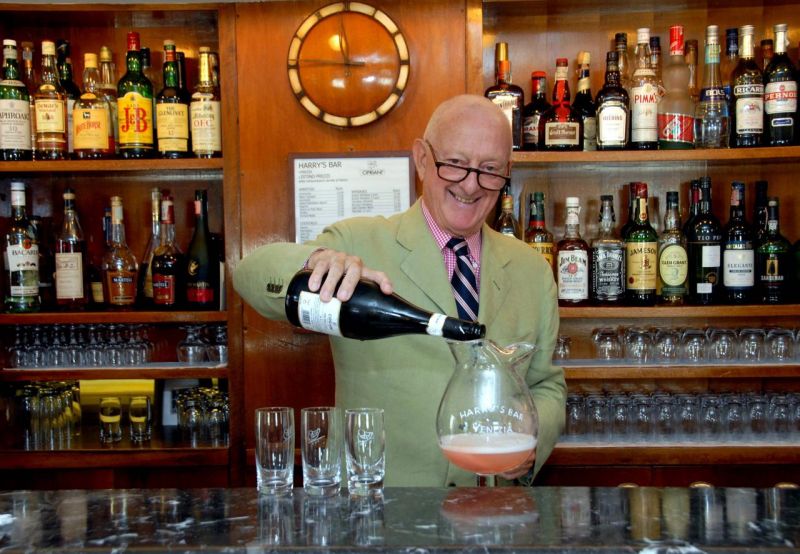 décor,
Harry’s Bar drew an international crowd, including
Americans who, until
1933, couldn’t get a drink in their own country.
décor,
Harry’s Bar drew an international crowd, including
Americans who, until
1933, couldn’t get a drink in their own country.
Commandeered as a Fascist canteen during the
war, Harry’s would re-open
to even greater acclaim and a celebrity guest list
that included Orson Welles,
Ernest Hemingway and most potentates of Europe, all
the while serving a small
menu of what became Cipriani classics, like the bellini cocktail, carpaccio,
tagliatelle
alla gratinate and risotto
with seppie.
Giuseppe and his son, Arrigo (right) ,
refused ever to open another restaurant
using the name Harry’s, but as of the 1980s,
Arrigo’s son did open restaurants
and function spaces under various Cipriani-related
names in New York, Miami,
Los Angeles, Abu Dhabi, Hong Kong, Monte Carlo,
Ibiza, Mexico City, Dubai,
Riyadh and Las Vegas, with more in the works. It is
the fourth generation of
Ciprianis, Maggio and Ignazio, that is now
overseeing HTC.
The sleek, airy space was designed by
London-based AD100 interior designer Martin
Brudnizki,
done in terrazzo, subway tiles, brass, natural wood,
globe chandeliers and blue
and orange colors, said to be inspired by a
traditional Italian street filled
with local vendors, such as a butcher and cheese
monger—though I know of no
street in Italy that remotely has the New York swank
of HTC.
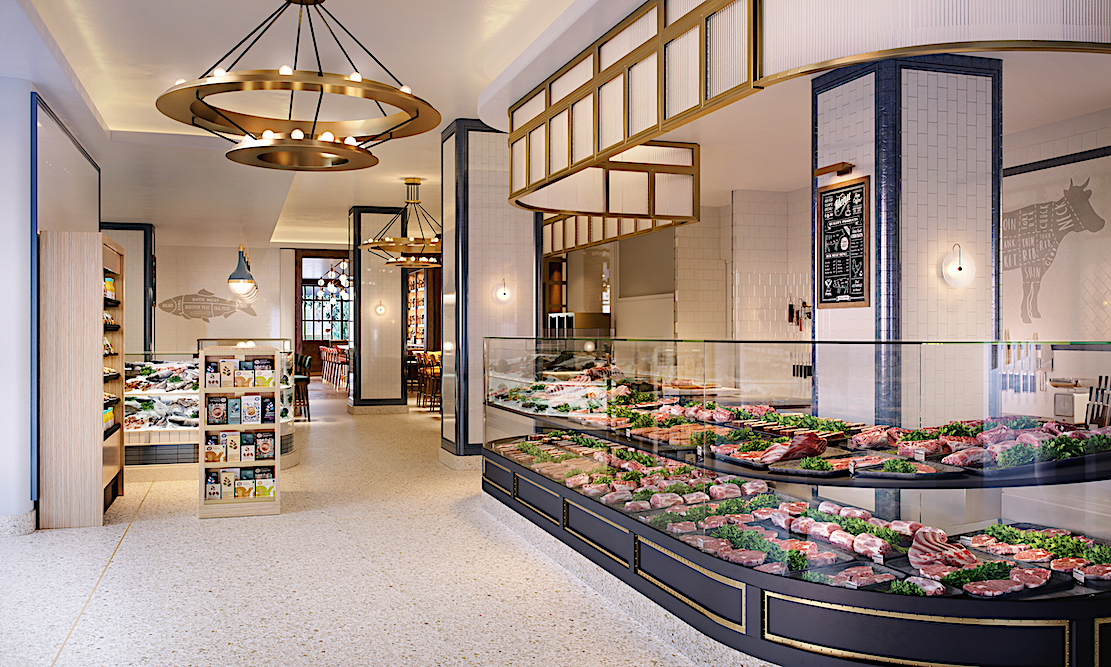 As you enter you see a long receding space
that curves around to the
Bellini restaurant in the rear, with a splendid
outdoor piazza set with tables
and ringed with lights facing the Hudson River. Up
front you’ll smell the
Lavazza Italian coffee being brewed and
out-of-the-oven pastries available as
of 7a.m. Then there is a gelateria
and pasticceria, where
you’ll find the renowned vanilla
meringue and lemon pie that are served in all
Cipriani restaurants. As you move
along you find a juice bar (which seems a tad out of
character for an Italian
food shop), then a place for signature salads.
As you enter you see a long receding space
that curves around to the
Bellini restaurant in the rear, with a splendid
outdoor piazza set with tables
and ringed with lights facing the Hudson River. Up
front you’ll smell the
Lavazza Italian coffee being brewed and
out-of-the-oven pastries available as
of 7a.m. Then there is a gelateria
and pasticceria, where
you’ll find the renowned vanilla
meringue and lemon pie that are served in all
Cipriani restaurants. As you move
along you find a juice bar (which seems a tad out of
character for an Italian
food shop), then a place for signature salads.
Fresh
pasta, such as ravioli and
tagliatelle, can be purchased
uncooked, or made to order for
take-out or eat-in, along with a “Gastronomia” of Italian
dishes like the Venetian baccalà
montecato, artichokes alla Romana
and lasagna alla bolognese.
By
this time you are only hallway around: next is the
stop for panini
sandwiches, including the
Venetian soft sandwiches called tramezzini.
The bread selections are impressive. Then you come
to the pescheria, stocked with a variety of
seafood (though the offerings
should be topped
with crushed ice,
not just sit on it). Carne comes
from
the on-premises New England-based Fossil Farms
Artisan Butcher offering an
impressive array of beef, lamb and pork, grass-fed,
as in Italy, although
corn-fed American beef has much more marbling.
Of course, there’s pizza (below) in
multiple variations, and then an
extraordinarily beautiful case of cheeses, most
Italian, and salumi. The
Ciprianis have always had a caviar clientele, so
they have a caviar and smoked
salmon section from Caviarteria, although, by
international law, Russian and
Iranian Caspian Sea caviar is banned from sale. Here
the offerings are all farm
raised elsewhere.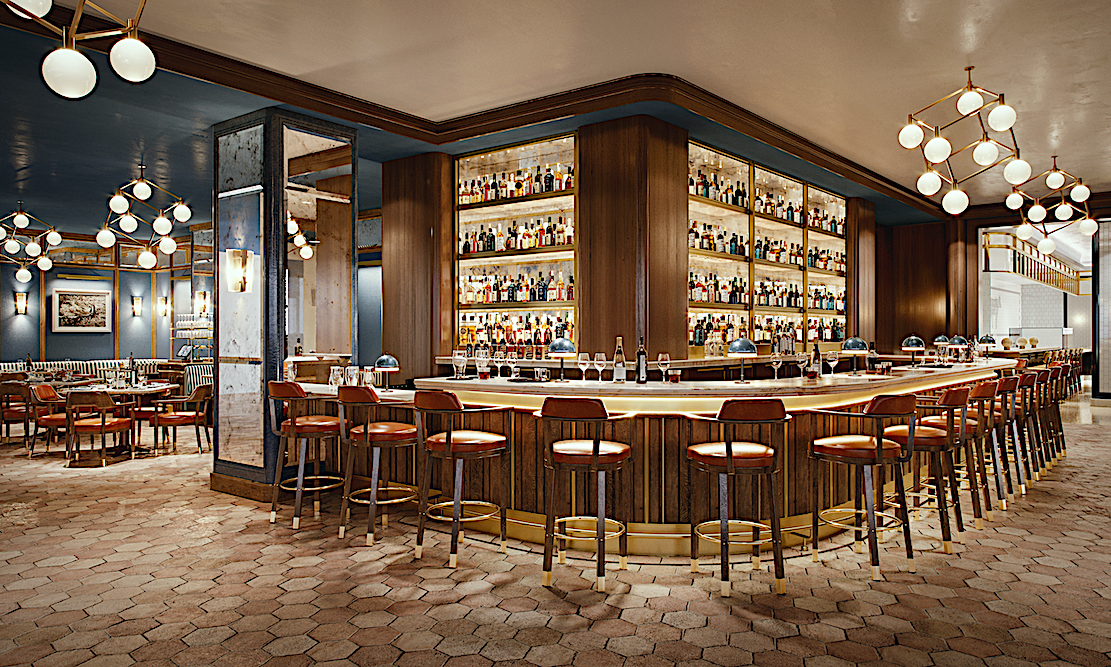
If you’ve come by to shop, you can also eat
at casual tables at HTC,
with the food brought to you if you like, including,
perhaps, a crudo
tasting. A
bright, glistening bar that evokes the
original Harry’s Bar is a fine spot for a bellini
or other cocktail or glass of wine before heading
home or to Lincoln Center.
If I lived in this Upper West Side
neighborhood, I might still go
occasionally to the local warehouse-like Whole Foods
or Fairway for non-Italian
products, and I might go to Citarella for something
special. But 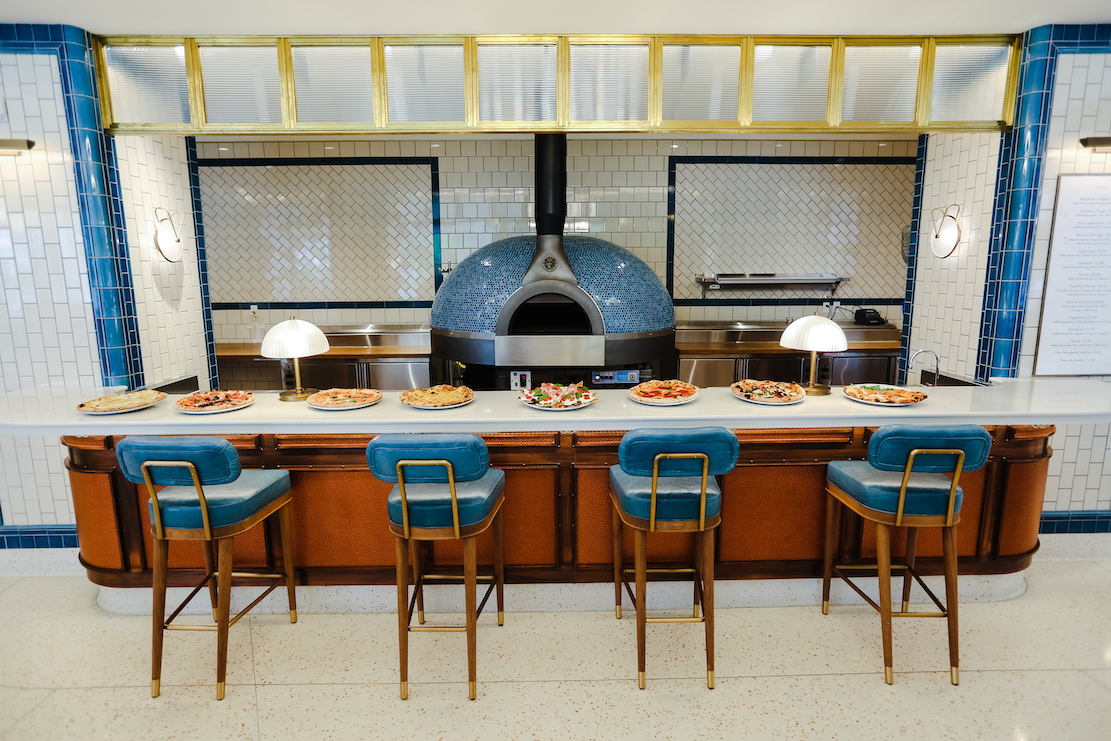 I
suspect I
might spend a good deal of time and money at HTC,
starting off with a
cappuccino and brioche in the morning, meeting a
friend for lunch, or cocktails
at six, and, if so inclined, to pick up some bread
and charcuterie, maybe a
little cheese, and, why not get a pizza, bring back
some pasta, and for a treat
a pint of gelato?
I
suspect I
might spend a good deal of time and money at HTC,
starting off with a
cappuccino and brioche in the morning, meeting a
friend for lunch, or cocktails
at six, and, if so inclined, to pick up some bread
and charcuterie, maybe a
little cheese, and, why not get a pizza, bring back
some pasta, and for a treat
a pint of gelato?
Had HTC had only these products, it would be
easy enough to do. But it’s
also such a beautiful space to linger in, I suspect
this would become my
neighborhood bar, grocery and place to get a bite of
this or that or that or
that, too. Since I do not live in
the
neighborhood, if I could find a parking space, I’d
go there for all the same
reasons.
Open
daily; Caffe 7 a.m.-9 p.m.; Market 11 a.m.-9
p.m.
❖❖❖
ANOTHER VERMEER

By John Mariani
ART TODAY
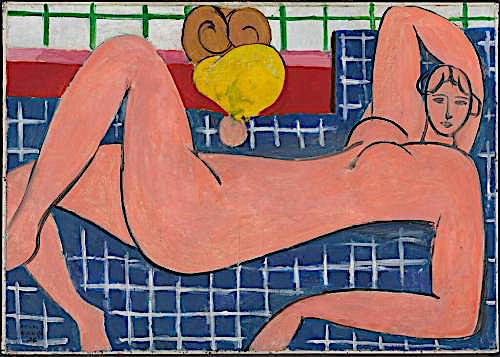
Matisse
Reclining
Nude Sells for Record $9.2 Million
An
Interview
with Taiwan Collector Hai Shui
`````````````````````````````````````````````````````````````````````````````````````````````````````````````````````````````
Art Today
came out
on Wednesday with a profile of Hai Shui, and
while it stated that the
billionaire was considered a very tough
businessman by many critics, the
article did not expose anything truly
nefarious about him. It did note that the
Shui family had been one of those to get gold
and artwork out of China during
the revolution and that much, if not most, of
it was in his private collection.
The article confirmed that Shui had not
donated much to Taiwan institutions.
Katie had expected such an article, after
hearing that Shui
had flown Coleman over and wined and dined him
in Taipei. So she pretty much
decided not to share information with her old
friend, who called her that day.
“What, you’re not speaking to me, Katie?”
asked Coleman.
“Not at all, but I just think we should
follow our own
investigations separately on the Vermeer
auction.”
“Gee, and I was just about to tell you
the news.”
Katie forced herself to be silent, then
said, “It’s up to
you if you want to tell me.”
“Well, it’s nothing everyone won’t read
next Wednesday
anyway. I’ve got the time and place of the
auction. It’s going to be November
25th, three days before Thanksgiving, which of
course they don’t celebrate over
there.”
“Okay,” said Katie, stifling any emotion.
“And the auction house is named
Crofthouse, in Hong Kong. A
small but well-regarded house long owned by the
Brits. Quite a coup for them.”
Katie was writing the information down
and said, “Well,
thanks, John. You’re a good guy. Just try to
understand where I’m coming from
with this.”
“I do, Katie, but cut me some slack here,
will you. I do the
best I can with the little I’m given, and Shui
handed me a plum.”
“We all gotta do what we gotta do,” she
said. “And
when this is all over, I’ll buy you
dinner. How’s that?”
“I’ll look forward to it, Katie. Maybe a
good Chinese
restaurant. And good luck with your research.”
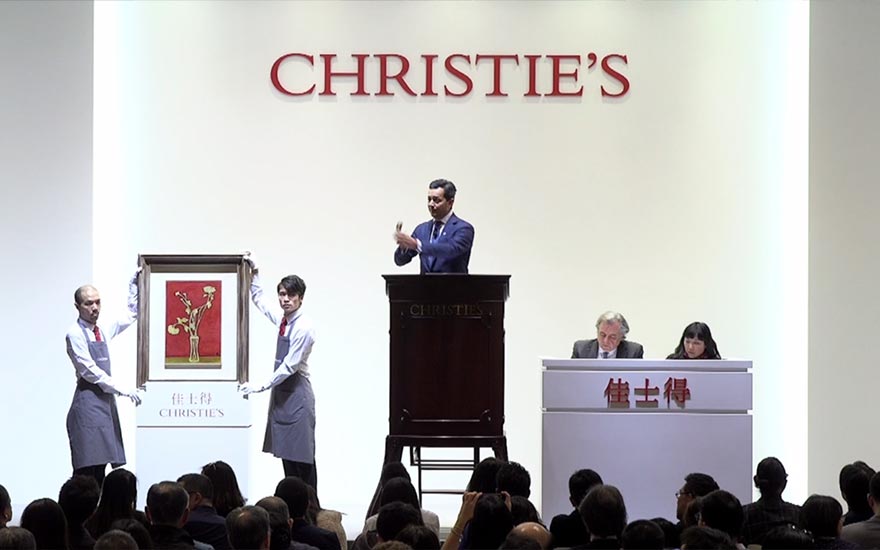 Katie
resigned herself to keeping on her track without
Coleman’s help, but as he himself said, she was
only getting advance notice of
info that would most likely be in the upcoming
issues of Art Today. And for her part she
really hadn’t given Coleman much of
anything useful for weeks.
Katie
resigned herself to keeping on her track without
Coleman’s help, but as he himself said, she was
only getting advance notice of
info that would most likely be in the upcoming
issues of Art Today. And for her part she
really hadn’t given Coleman much of
anything useful for weeks.
She phoned David and told him the news,
saying she’d put in
the appropriate calls to Crofthouse for their
official comment, then called Sotheby’s
and Christie’s to get theirs. As expected,
Sotheby’s and Christie’s had no
comment beyond wishing Crofthouse good luck with
the sale, so she called Kevin
O’Keeffe at the Mannion Gallery in New York, and
asked his response.
“Off the record?” asked O’Keeffe.
“You mean not for attribution?”
“Right, I don’t want to be named.”
“Okay, shoot.”
“This all seems very, very strange, but
in a way I
understand why the Chinese are choosing
Crofthouse. First, it’s located right
there in Hong Kong.”
“But don’t Sotheby’s and Christie’s have
offices there?”
“Yeah, Sotheby’s been there since the
seventies, Christie’s
since the eighties. Both sell primarily Asian
art. Crofthouse goes way back as
a British house, opening, I think, in the
fifties, so they’ve got a lot of
clout in that region and all the necessary
contacts and connections with the
mainland Chinese. Now that the Chinese regained
sovereignty over Hong Kong in '97, Crofthouse
would be a natural choice.
“But there’s another reason I think they
chose Crofthouse:
The painting has to be vetted, and I’m sure
Sotheby’s and Christie’s would
demand a much more vigorous investigation into
provenance and authenticity,
which, as you know, with that other supposed
Vermeer in the market, could take
a very long time. Something tells me Crofthouse
is willing to be a little less
demanding in that regard, probably arranging for
a few Vermeer scholars to take
a close look at the painting, maybe allow an
x-ray, but then put the piece up
for sale as scheduled. It would be a huge public
relations coup for
Crofthouse—which also stands to make at least
$10 million off the sale—and make
them the conduit for any sales the Chinese
arrange in the future. Asia is
becoming a very big market for art.”
“And, if it turns out to be a fake?”
asked Katie.
“Crofthouse won’t look so good, but with
the backing of the
experts and the Chinese government, I don’t
think they’re risking being
sued. Also,
authenticity is warranted
for only five years, and if the buyer cries foul
a year after the auction, the
burden of proof is on him, not the auction
house. It’s
tricky these days but this is China, not
Europe or the U.S.”
Katie asked, “Do you have a name I could
call at
Crofthouse?”
“Matter of fact, I know one of the
principals quite well. We
buy from and sell to each other. Name is Derrick
Donaldson, good man.”
“You think he’ll talk to me?”
“I’m happy to give him a call in
advance,” said O’Keeffe.
“I’ll let you know tomorrow.”
Now on this new trail, Katie also called
Prof. Elizabeth
Horner at Fordham, asking if she knew who the
Vermeer scholars were who were
going for the inspection. Horner gave her three
names, Andrea Kenner at the Rijksmuseum in
Amsterdam, Jacob Strohe at the Kunstmuseum (right)
in
Vienna and Marie-Céline Bourget at the Louvre in
Paris.
“And you think their reputations are
solid enough that
they’ll give their honest opinion?” asked Katie.
“They’ll be paid a great deal of money,
I’m sure,” replied
Horner. “That can sway a person, but they are
first-rate scholars, and if
there’s something readily suspicious about the
painting, they’ll certainly
report it.
Three pairs of eyes and
magnifying glasses are going to go over every
inch of that painting.”
It wasn’t easy getting to the experts.
Two of them, Strohe
and Bourget, had already left for Hong Kong.
Kenner was due to leave soon, and
Katie was able to reach her at her office in the
Rijksmuseum (below).
After the expected demurral about not
being able to say
anything authoritative until she saw the
painting, Kenner said she believed it
might very well be a Vermeer, based on the
photographs she’d seen.
“If it’s not a Vermeer,” she said, “it
looks to be an impeccable forgery.
The fact that it seems to be a third in a series
of scientists is interesting,
too, at a time when interest in science was
growing very rapidly in Holland.”
 Katie
thought for a moment whether to tell Kenner
about the
alchemy reference, then did so, believing the
more Katie sounded like she knew
what she was talking about the more likely
Kenner would be to speak.
Katie
thought for a moment whether to tell Kenner
about the
alchemy reference, then did so, believing the
more Katie sounded like she knew
what she was talking about the more likely
Kenner would be to speak.
“Ah, yes,” said Kenner, “that was very
obvious from the
tools and beakers in the painting, which should
more properly be called The
Alchemist. And there might be some
symbolic reference in the fact that the globe—we
know where it came from—is
deliberately turned towards China, but it’s not
clear to me why.”
Katie decided it would sound too
conjectural to get into the
supposed connection to China’s seeking gold from
the West or about the Shui
family. She
thanked Kenner and asked if
she might check with her as her investigations
went along.
“I’m afraid none of us can speak to
anyone about that until
we release our official findings.”
A day later Katie was able to speak with
Jacob Strohe, who
said the same thing about the ongoing work.
“I have spent an hour or so with the
painting,” he said,
“and I can only say I am impressed with what
I’ve seen. But that is a very
preliminary opinion. We are also waiting for the
results of an x-ray, which
will tell us more.”
It took two more days to reach
Marie-Céline Bourget, who
refused any comment whatever beyond saying that
the painting was in fairly good
condition and that her work, along with Kenner
and Strohe, was made easier by
not having to imagine what was under layers of
dirt and varnish.
“Is there anything about the painting
that you think may be
a problem?” asked Katie.
“Nothing obvious right now,” Bourget said
in Oxford-accented
English with a French lilt. “I am a little
suspicious about the way the artist
rendered the right sleeve of the figure, which
doesn’t match the refinement
seen in the other two scientist paintings. You
know, we have The
Astronomer at the Louvre, so I am
very intimately familiar with that work.
But not much else is troubling me right
now.”
© John Mariani, 2016
❖❖❖
CHABLIS: A GOOD BISTRO WINE
BUT AN EXCELLENT BURGUNDY, TOO
By John Mariani

What’s in a name? In the case of Chablis,
far more than the producers of this white Burgundy
wine would like to hear. For
“chablis” is one of those wine names that has
acquired a freewheeling, generic
usage in the market. Many countries, including the
U.S., appropriate the name
without any relevance to the true Chablis.
American wine giant Gallo even makes
a Blush Chablis under its Livingston label.
 True
Chablis, which takes its name from a
town of that name, can be a superb white wine, made
exclusively from Chardonnay
grapes, although it rarely reaches the level of more
prestigious white
burgundies made to the south in the Côte de Beaune.
Chablis is made under
strict French wine regulations that designate the
region’s vineyards. The best
of these are the 7 Grand Crus and the 17 Premier
Crus.
True
Chablis, which takes its name from a
town of that name, can be a superb white wine, made
exclusively from Chardonnay
grapes, although it rarely reaches the level of more
prestigious white
burgundies made to the south in the Côte de Beaune.
Chablis is made under
strict French wine regulations that designate the
region’s vineyards. The best
of these are the 7 Grand Crus and the 17 Premier
Crus.
About 32
million bottles of Chablis are
made each year from vineyards comprising 4,300
hectares (10,500 acres) in 20
villages. About a third of that is vinified by the
cooperative La Chablisienne,
but more and more individual proprietors are now
bottling their own Chablis,
leading to different styles of the wine.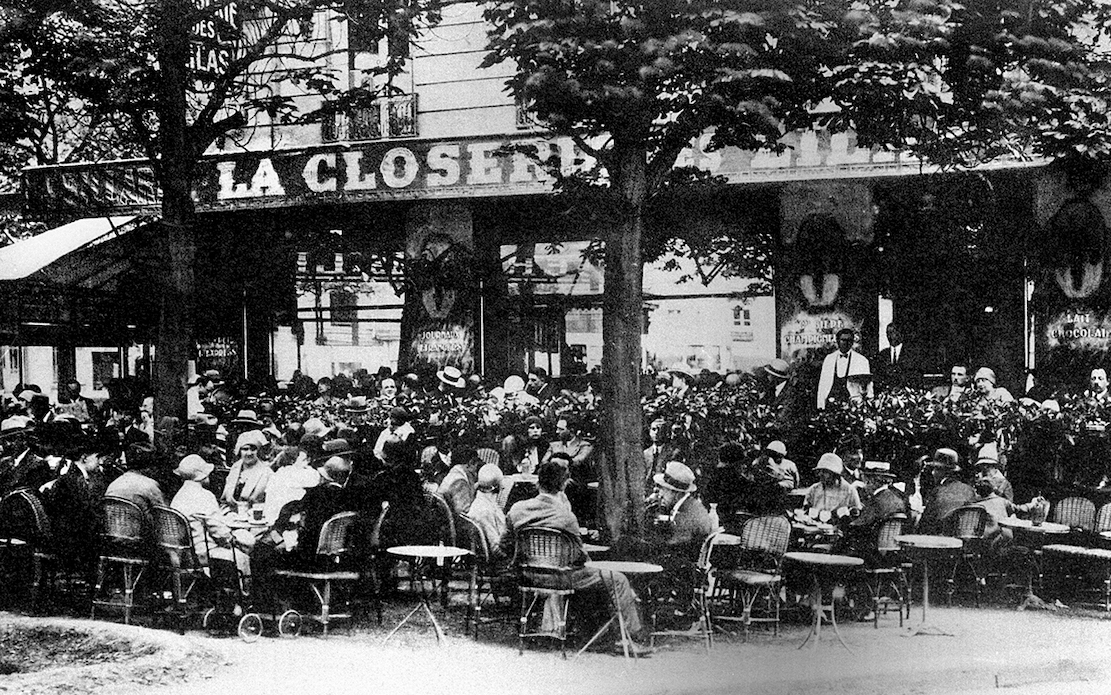
Two centuries ago Chablis was vastly
successful as a cheap white wine easily shipped to
nearby Paris. When railroads
proliferated in France the mid-19th century, wines
shipped from regions farther
away challenged Chablis’ dominance of the market.
Still, Chablis endures as the
steely, mineral-rich wine traditionally quaffed with
oysters and shellfish in
Parisian bistros like La Rotonde, La Coupole, and
Closerie des Lilas.
The identifying mineral character of
Chablis comes from soil rich in limestone, clay, and
fossilized oyster shells.
There has been a debate in recent years among
producers as to whether Chablis
should be aged in oak barrels. Many producers
believe Chablis retains its
distinctive “gunflint” (“pierre à fusil”)
flavor
better in the sterile atmosphere of stainless steel;
others,
particularly among the Grand Cru and Premier Cru
producers, say a few months in
oak imparts more character to Chablis.
What I love about good Chablis is its
distinctive quality and its lack of pretension. It
should be drunk cold, in or
out of doors, and goes as well with lunch as with
dinner, with fish as well as
chicken. In The
Sun Also Rises Ernest
Hemingway wrote of his characters drinking Chablis
with sandwiches while on the
train from Paris to Spain, noting, “The grain was
just beginning to ripen and
the fields were full of poppies.”
Perhaps more important
to Chablis’
character is the time it takes to mature in the
bottle. Unlike most white wines
in the world, including California Chardonnays,
Grand and Prémier Cru Chablis
may not reach their peak for seven to fifteen years,
the same as big name
burgundies like Meursault and Corton-Charlemagne.
Over time, Chablis’ flavors
deepen, the minerals and acids come into balance and
the bouquet develops. For
this reason the better Chablis are not released for
two or more years. Right
now wine from the highly regarded 2020 vintage is
available at wine shops.
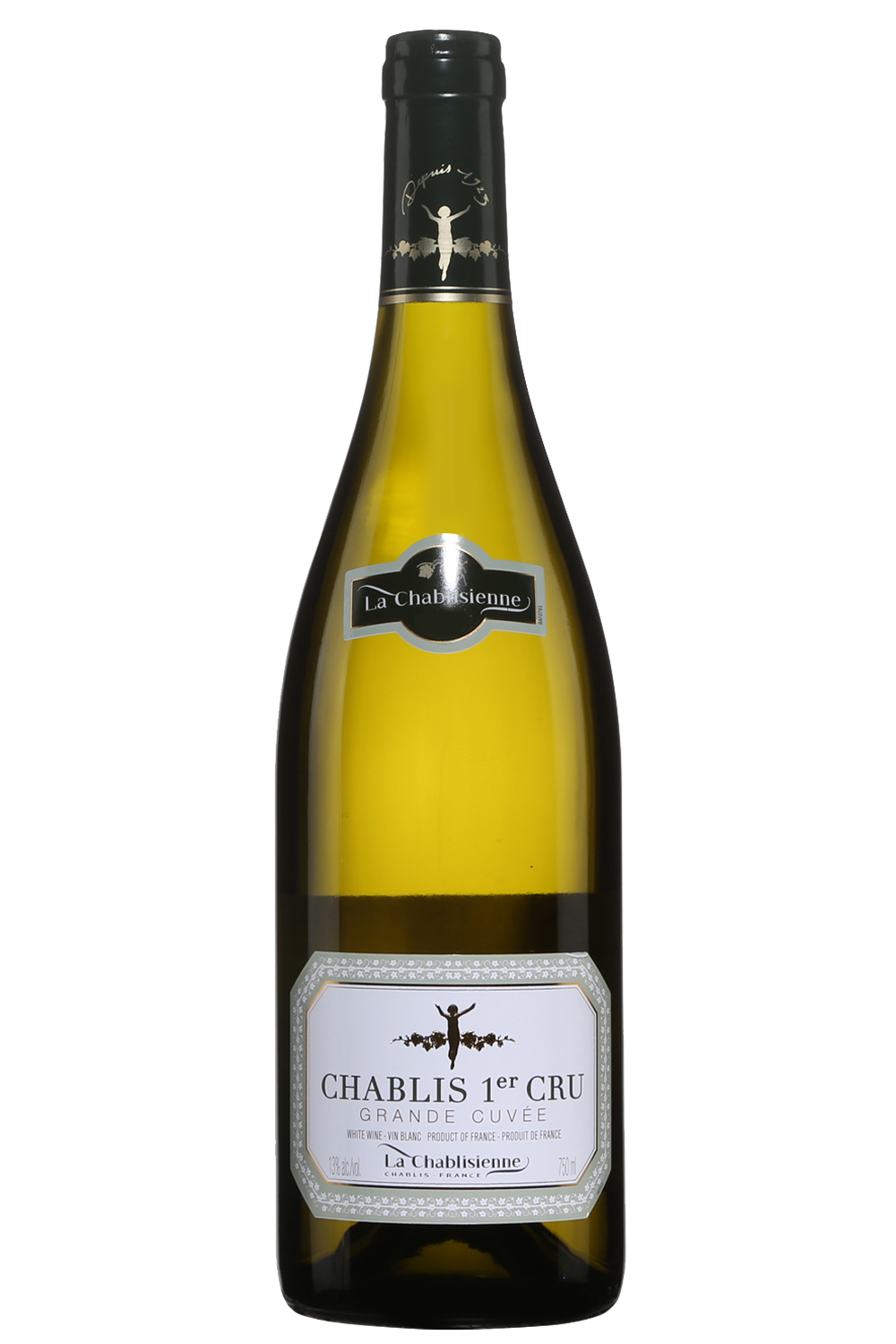
La Chablisienne Premier Cru 2020 ($30)—A classic effort from Vaillon, well made, flinty but with good fruit, ideal with chilled fresh oysters, or mussels with a touch of mayonnaise.
Jean-Paul & Benoit Droin’s Premier Cru 2020 ($30)—Chablis from the Montmains vineyard has always shown a perky acidity, with the nose tight, the minerals in modest evidence, all of which should come into balance in a year or two. The producer has yet to release its 2020 Grand Cru.
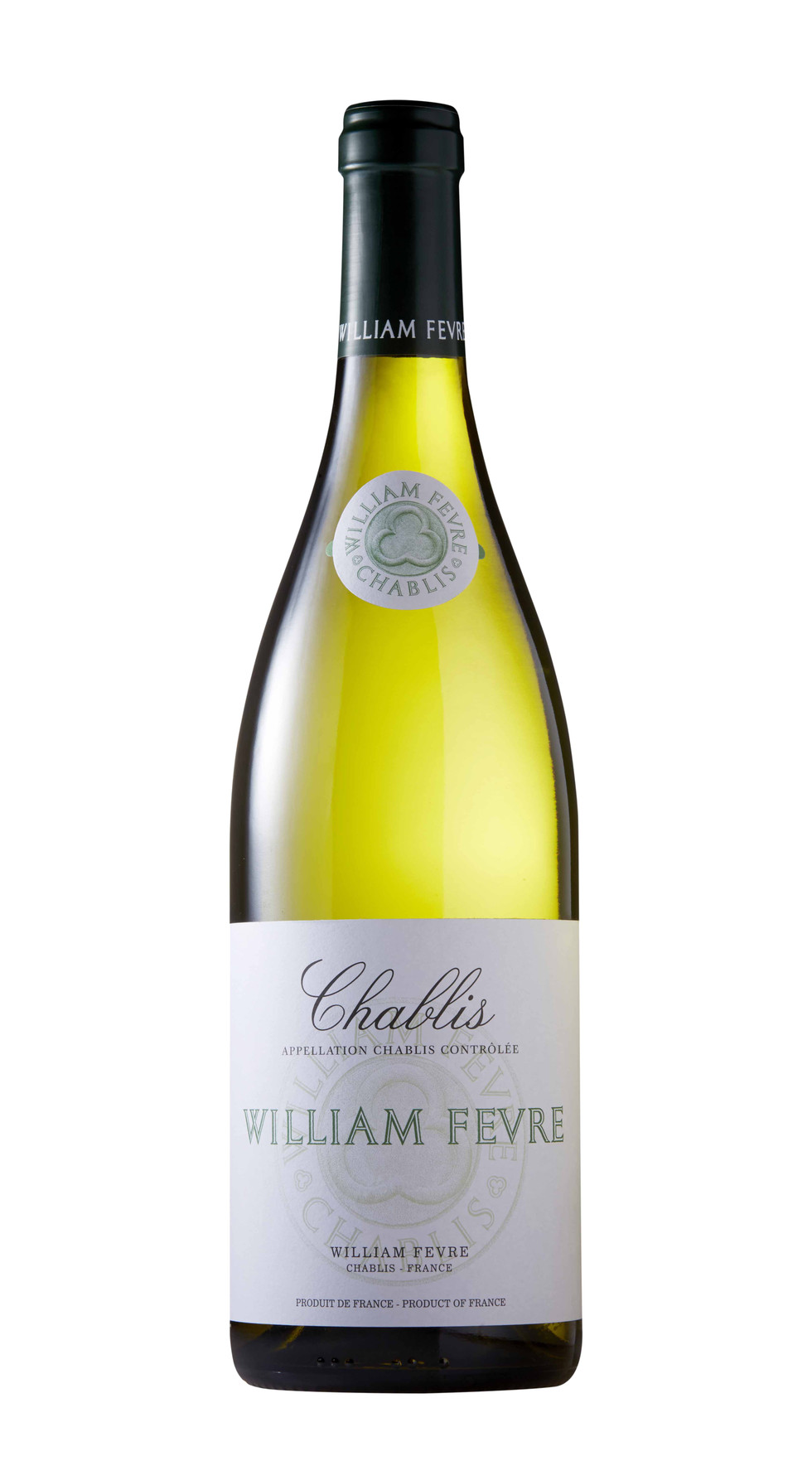
Jean-Marie Brocard’s Premier Cru Montmains 2020 ($35)—Shows some real finesse and complexity, but this is one I want to hold onto because a few years from now it should really be magnificent.
Domaine William Fevre 2020 ($55)—From Bougros, with lots of mineral notes both in the nose and the taste. First came an acidic rush, then vibrant tingles of that gunflint flavor that distinguishes Chablis from the rest of Burgundy’s wines. Its Premier Cru costs about double.
There is still a lot of cheap, inferior Chablis from France on the market, so if you like the taste of the wine, it’s better to buy from the Grand Cru and Premier Cru categories, even if you have to wait a while for them to reach their peak.
Below the Grand Cru and Premier Cru categories (which themselves may be de-classified if the wine doesn’t meet quality standards) bottles are labeled just Chablis, with no vineyard names attached (there is also an even lower category called Petit Chablis). So, more or less, you get what you pay for, and that should not be upwards of $15. If you do buy one of those, maybe pour it into a carafe and serve it up with oysters and charcuterie, the way they do at a Paris bistro. At least it will be authentic.
❖❖❖

WHICH BEGS THE QUESTION, WHAT THE HELL
WERE THEY PUTTING IN THEM BEFORE?
"It’s
Time to Put Actual Veggies Back
Into Veggie Burgers" by Jaya Saxena, Eater.com
(7/15/22)
❖❖❖
Any of John Mariani's books below may be ordered from amazon.com.
 The Hound in Heaven
(21st Century Lion Books) is a novella, and
for anyone who loves dogs, Christmas, romance,
inspiration, even the supernatural, I hope you'll find
this to be a treasured favorite. The story
concerns how, after a New England teacher, his wife and
their two daughters adopt a stray puppy found in their
barn in northern Maine, their lives seem full of promise.
But when tragedy strikes, their wonderful dog Lazarus and
the spirit of Christmas are the only things that may bring
his master back from the edge of despair.
The Hound in Heaven
(21st Century Lion Books) is a novella, and
for anyone who loves dogs, Christmas, romance,
inspiration, even the supernatural, I hope you'll find
this to be a treasured favorite. The story
concerns how, after a New England teacher, his wife and
their two daughters adopt a stray puppy found in their
barn in northern Maine, their lives seem full of promise.
But when tragedy strikes, their wonderful dog Lazarus and
the spirit of Christmas are the only things that may bring
his master back from the edge of despair. WATCH THE VIDEO!
“What a huge surprise turn this story took! I was completely stunned! I truly enjoyed this book and its message.” – Actress Ali MacGraw
“He had me at Page One. The amount of heart, human insight, soul searching, and deft literary strength that John Mariani pours into this airtight novella is vertigo-inducing. Perhaps ‘wow’ would be the best comment.” – James Dalessandro, author of Bohemian Heart and 1906.
“John Mariani’s Hound in Heaven starts with a well-painted portrayal of an American family, along with the requisite dog. A surprise event flips the action of the novel and captures us for a voyage leading to a hopeful and heart-warming message. A page turning, one sitting read, it’s the perfect antidote for the winter and promotion of holiday celebration.” – Ann Pearlman, author of The Christmas Cookie Club and A Gift for my Sister.
“John Mariani’s concise, achingly beautiful novella pulls a literary rabbit out of a hat – a mash-up of the cosmic and the intimate, the tragic and the heart-warming – a Christmas tale for all ages, and all faiths. Read it to your children, read it to yourself… but read it. Early and often. Highly recommended.” – Jay Bonansinga, New York Times bestselling author of Pinkerton’s War, The Sinking of The Eastland, and The Walking Dead: The Road To Woodbury.
“Amazing things happen when you open your heart to an animal. The Hound in Heaven delivers a powerful story of healing that is forged in the spiritual relationship between a man and his best friend. The book brings a message of hope that can enrich our images of family, love, and loss.” – Dr. Barbara Royal, author of The Royal Treatment.
 |
The Encyclopedia of American Food and Drink by John F. Mariani (Bloomsbury USA, $35) Modesty forbids me to praise my own new book, but let me proudly say that it is an extensive revision of the 4th edition that appeared more than a decade ago, before locavores, molecular cuisine, modernist cuisine, the Food Network and so much more, now included. Word origins have been completely updated, as have per capita consumption and production stats. Most important, for the first time since publication in the 1980s, the book includes more than 100 biographies of Americans who have changed the way we cook, eat and drink -- from Fannie Farmer and Julia Child to Robert Mondavi and Thomas Keller. "This book is amazing! It has entries for everything from `abalone' to `zwieback,' plus more than 500 recipes for classic American dishes and drinks."--Devra First, The Boston Globe. "Much needed in any kitchen library."--Bon Appetit. |
"Eating Italian will never be the same after reading John Mariani's entertaining and savory gastronomical history of the cuisine of Italy and how it won over appetites worldwide. . . . This book is such a tasteful narrative that it will literally make you hungry for Italian food and arouse your appetite for gastronomical history."--Don Oldenburg, USA Today. "Italian
restaurants--some good, some glitzy--far
outnumber their French rivals. Many of
these establishments are zestfully described
in How Italian Food Conquered the World, an
entertaining and fact-filled chronicle by
food-and-wine correspondent John F.
Mariani."--Aram Bakshian Jr., Wall Street
Journal.
"Equal parts
history, sociology, gastronomy, and just
plain fun, How Italian Food Conquered the
World tells the captivating and delicious
story of the (let's face it) everybody's
favorite cuisine with clarity, verve and
more than one surprise."--Colman Andrews,
editorial director of The Daily
Meal.com. "A fantastic and fascinating
read, covering everything from the influence
of Venice's spice trade to the impact of
Italian immigrants in America and the
evolution of alta cucina. This book will
serve as a terrific resource to anyone
interested in the real story of Italian
food."--Mary Ann Esposito, host of PBS-TV's
Ciao
Italia. "John Mariani has written the
definitive history of how Italians won their
way into our hearts, minds, and
stomachs. It's a story of pleasure over
pomp and taste over technique."--Danny Meyer,
owner of NYC restaurants Union Square
Cafe, The Modern, and Maialino.
|
 |
 |
 |
 |
 |
 |
 Everett Potter's Travel Report:
Everett Potter's Travel Report: 
 Eating Las
Vegas
Eating Las
Vegas
MARIANI'S VIRTUAL GOURMET
NEWSLETTER is published weekly. Publisher: John Mariani. Editor: Walter Bagley. Contributing Writers: Christopher
Mariani, Misha Mariani, John A. Curtas, Gerry Dawes, Geoff Kalish.
Contributing
Photographer: Galina Dargery. Technical
Advisor: Gerry
McLoughlin.
If you wish to subscribe to this
newsletter, please click here: http://www.johnmariani.com/subscribe/index.html
© copyright John Mariani 2022
